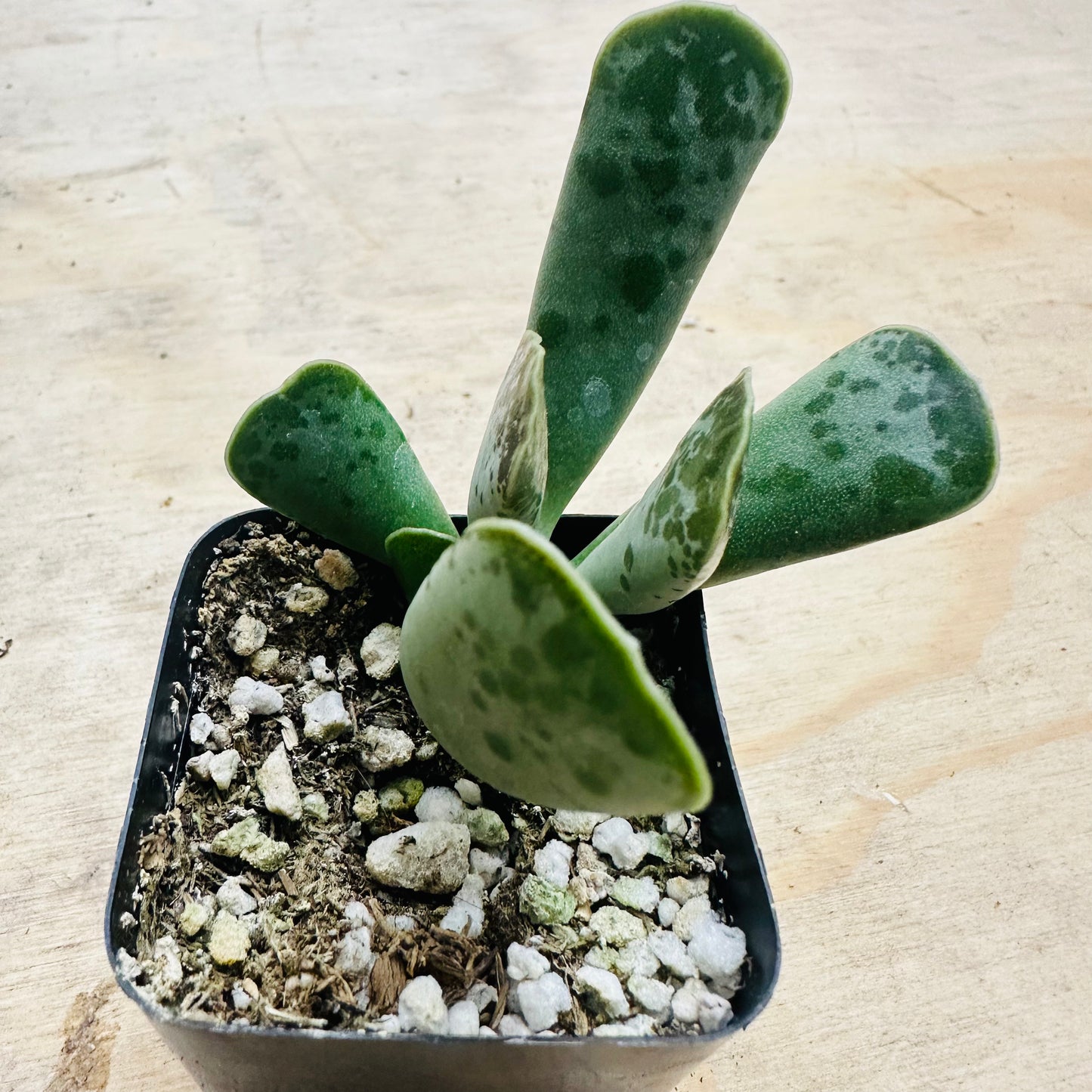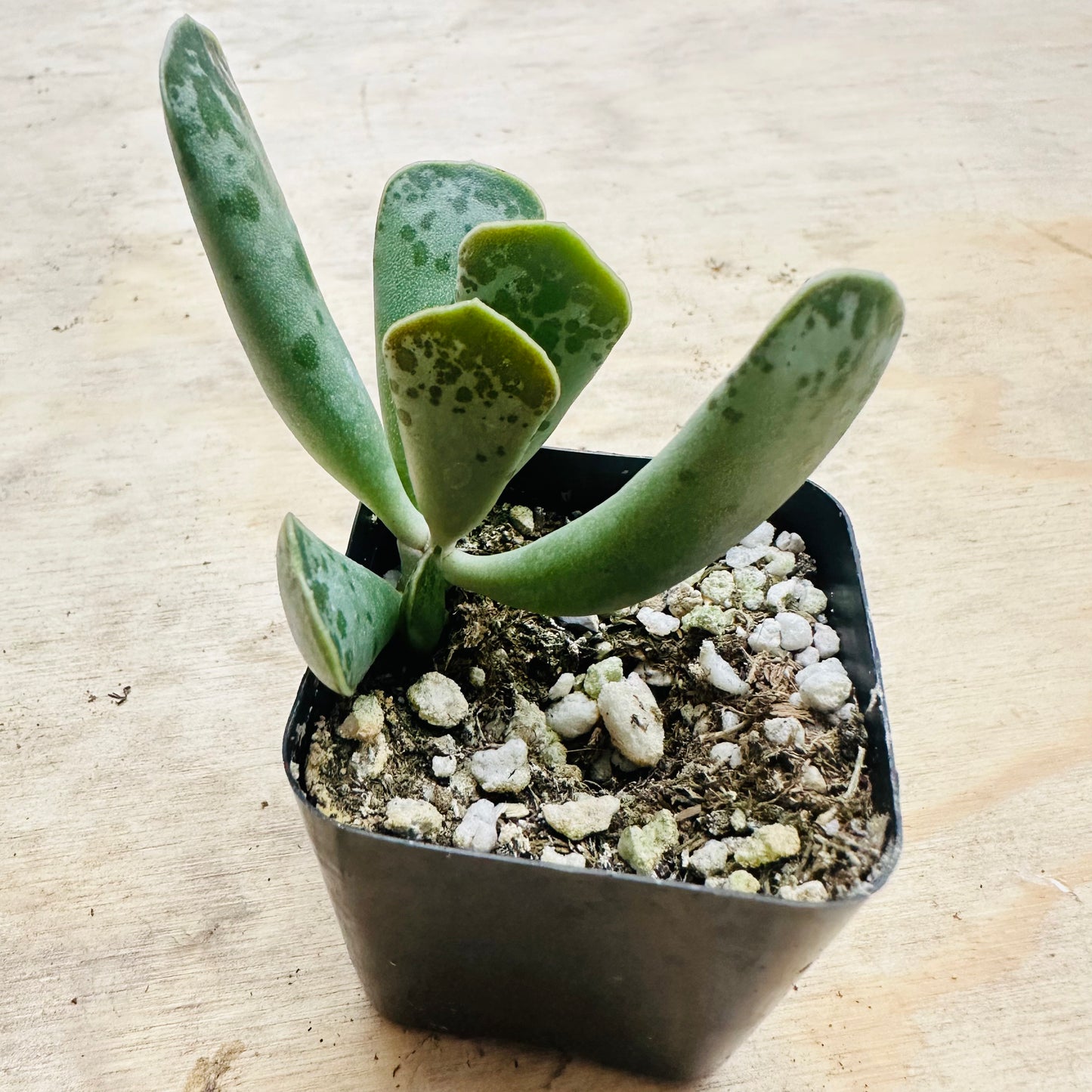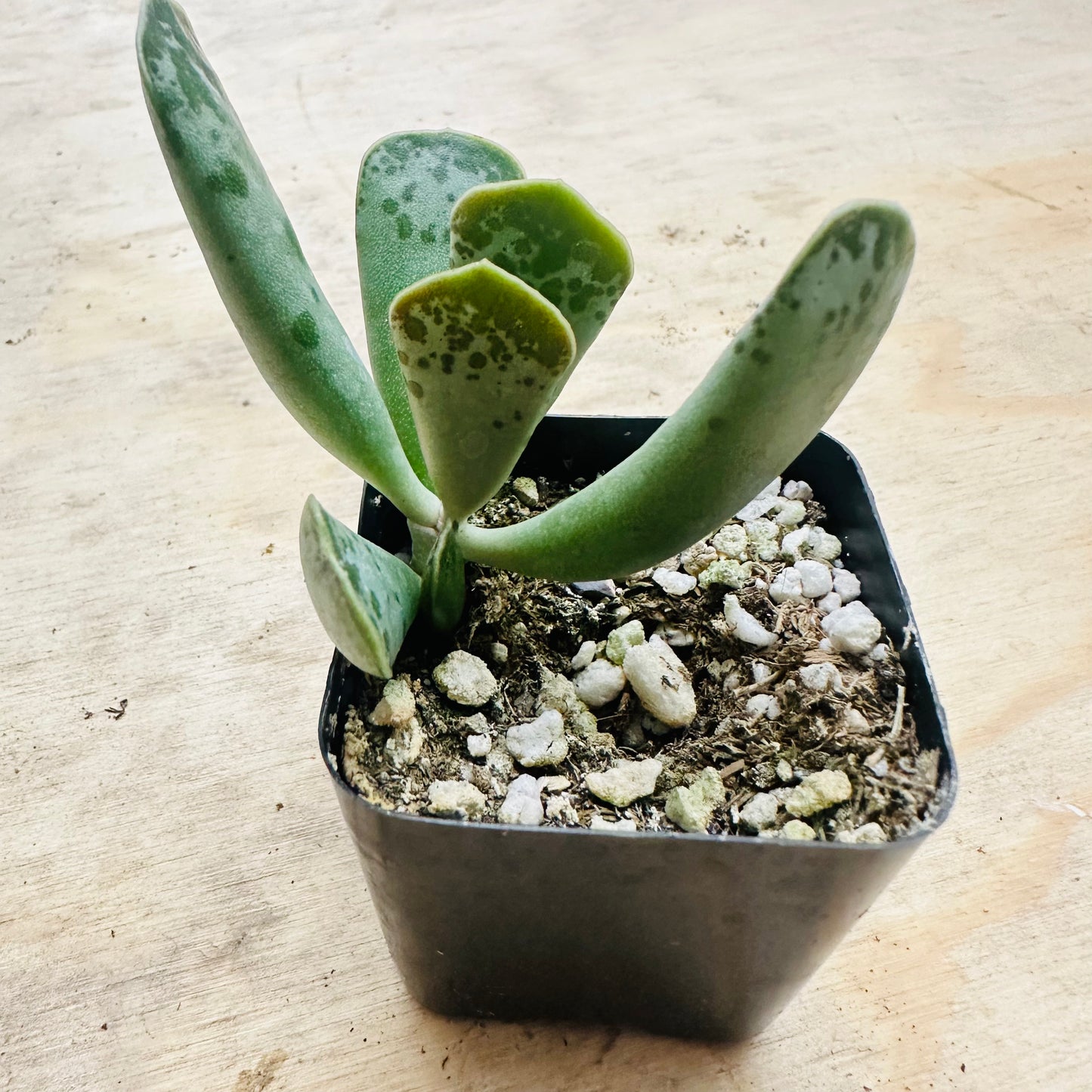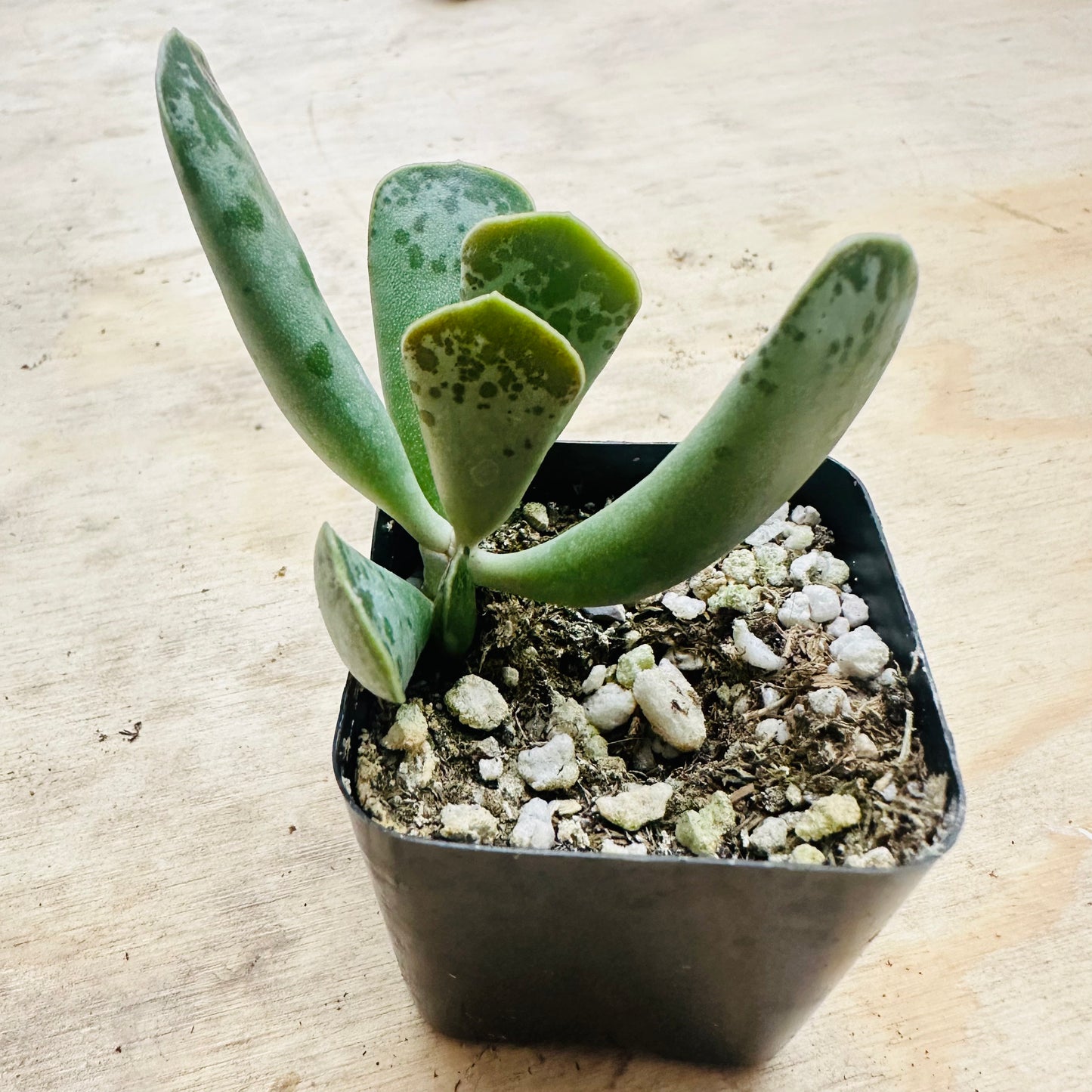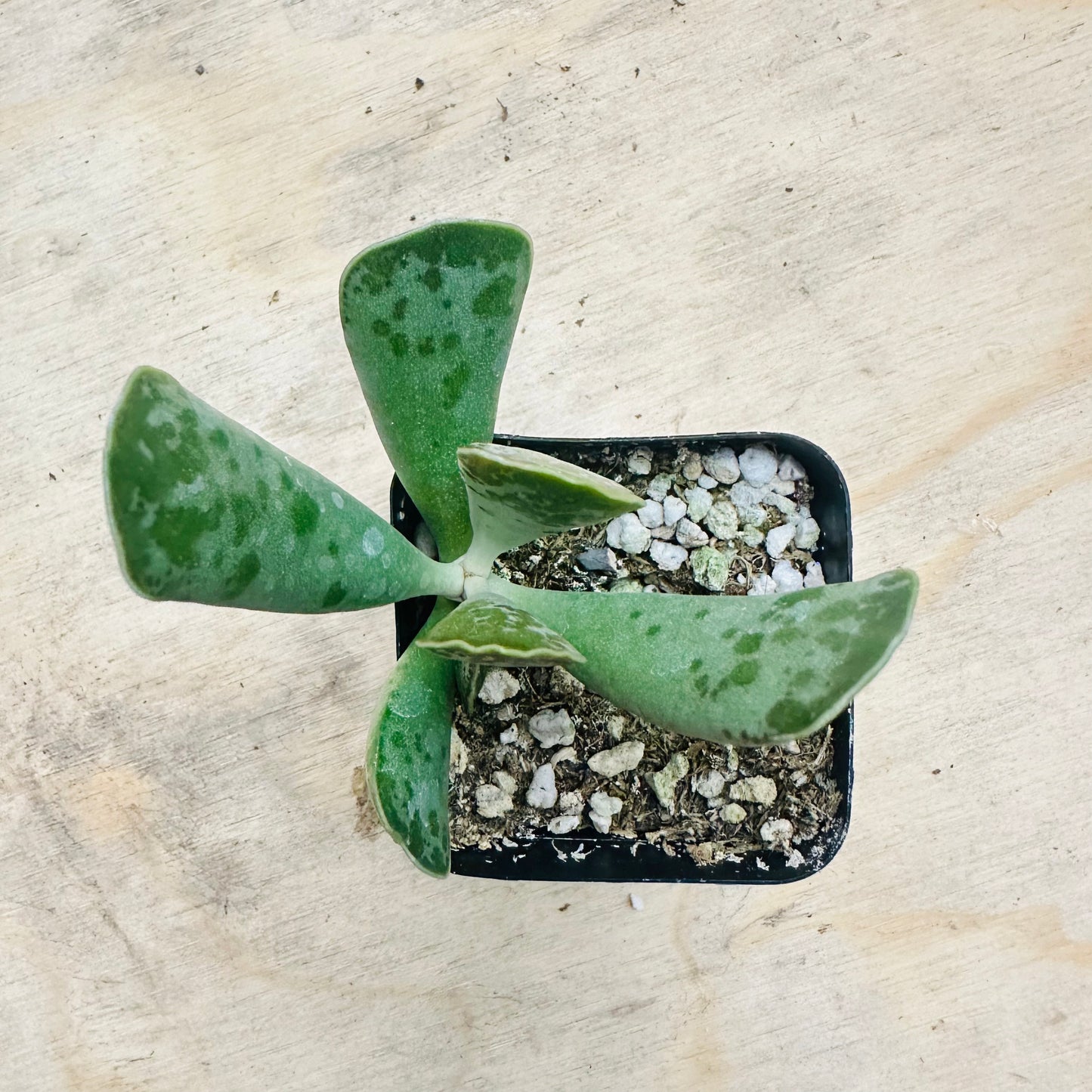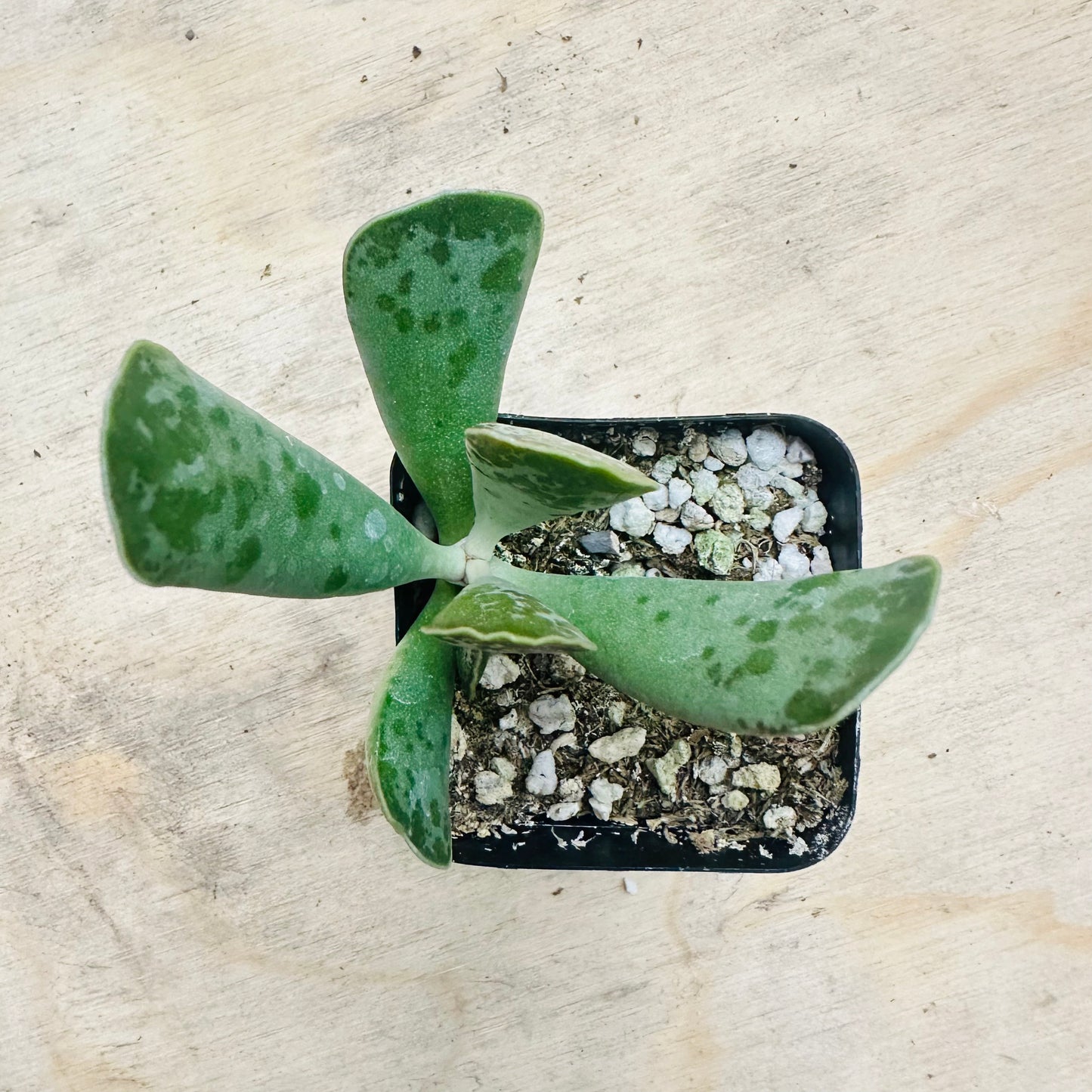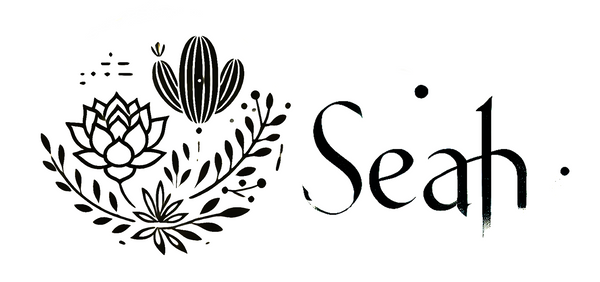Adromischus cooperi - Plover Eggs
Adromischus cooperi - Plover Eggs
In stock
Couldn't load pickup availability
📝 Description
Morphological Characteristics
Adromischus cooperi, commonly known as Plover Eggs, is a charming succulent in the Crassulaceae family, native to South Africa. The name “Plover Eggs” comes from the plant’s distinctive spotted, oval-shaped leaves that resemble bird eggs—specifically those of the plover.
This small, low-growing succulent typically forms a loose rosette or clump of short stems, each bearing a few fleshy, oval to spoon-shaped leaves. The leaves are light gray-green to bluish-green, with irregular dark purple to reddish spots or blotches, giving them a speckled or marbled appearance. The leaf surface may appear slightly powdery or waxy due to a natural protective coating.
The plant typically stays compact, reaching 5–10 cm (2–4 inches) in height and spreading slowly. In late spring to summer, it may produce thin flower stalks (up to 15 cm tall) bearing small tubular pink to greenish flowers, though these are modest and not the primary ornamental feature.
Growth Habits
Adromischus cooperi is a slow-growing succulent with a compact and tidy form. It grows well in shallow pots or dish gardens and is a favorite among collectors due to its unique foliage pattern and easy care. It remains a solitary or lightly clustering plant and rarely spreads aggressively.
Maintenance Points
• Lighting: Prefers bright, indirect light or filtered sun. Direct afternoon sunlight in hot climates can cause sunburn, but too little light may fade the leaf patterns.
• Watering: Water moderately during the growing season (spring to autumn). Let the soil dry out completely between waterings. Reduce watering in winter. Overwatering can cause leaf drop or rot.
• Soil: Use a well-draining succulent or cactus mix. Amending with perlite or pumice helps improve aeration and drainage.
• Temperature: Ideal temperature range is 18–27°C (65–80°F). Can tolerate temperatures down to 4°C (40°F) if kept dry, but not frost-hardy.
• Fertilization: During the growing season, feed once a month with a diluted succulent fertilizer. Avoid fertilizing during winter dormancy.
• Potting: Choose small, shallow pots with drainage holes. Repot every 2–3 years, preferably in early spring, to refresh the soil.
• Humidity: Prefers low humidity. Good air circulation helps prevent fungal problems.
Reproduction Method
1. Leaf Cuttings (most common):
• Selection: Gently twist off a healthy, mature leaf from the base.
• Callusing: Let it dry and callus for 3–5 days in a shaded, dry area.
• Planting: Place the leaf on top of well-draining soil. Do not bury.
• Aftercare: Mist lightly until roots form (1–2 weeks), then water sparingly. New plantlets will sprout from the base of the leaf.
2. Offsets (if present):
Occasionally, small side shoots may develop and can be separated and replanted.
Additional Tips
• Pest Control: Occasionally susceptible to mealybugs and aphids. Inspect regularly and treat promptly with insecticidal soap or neem oil.
• Disease Prevention: Avoid water sitting on the leaves or in the crown to prevent rot.
• Pruning: Remove dried or fallen leaves to keep the plant tidy and prevent pests.
• Display: Looks great in shallow ceramic bowls, geometric planters, or with contrasting succulents in mixed arrangements.
• Safety Note: Generally non-toxic, but always handle gently to avoid snapping delicate leaves.
With its striking spotted foliage and easy-care nature, Adromischus cooperi – Plover Eggs is a wonderful choice for both beginners and seasoned succulent collectors. Its compact size and whimsical leaf patterns add character to any windowsill, desk, or indoor garden.
🌿 Care Tips
Plant Care
Light
Water
Soil
Temperature
Hardiness
Fertilizer
Propagation: Leaf/offset cuttings
Common issues: Etiolation, mealybugs, rot
🌟 Note: It’s normal for succulents to appear slightly shriveled after shipping. They usually recover within a few days in a suitable environment.
📦 Shipping Info
Seah Shipping Policy
Effective Date: November 2025
This Shipping Policy applies to orders delivered within the continental United States (the lower 48 states). By purchasing from Seah, you agree to the terms below.
1) Shipping Cost & Free Shipping
- Automatic rate calculation: Shipping is calculated at checkout based on weight, destination ZIP and carrier rates.
- Free Standard Shipping: Orders $59+ (pre-tax, after discounts) ship free to the lower 48 states.
- Alaska, Hawaii, Puerto Rico & other territories: Not eligible for free shipping or standard flat offers at this time.
- Taxes/Duties: Applicable sales tax and any fees are shown at checkout.
2) Processing Schedule
- Business days only: We process and ship Monday–Friday. No shipping on weekends or U.S. federal holidays.
- Handling time: 1–3 business days after payment confirmation.
- Cut-off time: Orders placed before 3:00 PM (PST) are prioritized for same-day processing; others roll to the next business day.
- Changes/Cancellations: Email support@seah.co within 12 hours of purchase; after that, the order may already be in processing.
3) Transit Times
| Method | Estimated Transit | Total ETA (Handling + Transit) |
|---|---|---|
| Standard | 5–8 business days | 6–11 business days |
| Express | 3–4 business days | 4–7 business days |
ETAs are estimates. Weather, holidays, carrier delays or high-volume periods may extend delivery times.
4) Seasonal Temperature & Plant Safety
- Winter (Nov–Mar): We strongly recommend adding a heat pack at checkout to protect plants from freezing. Orders shipped without a heat pack during cold conditions are not covered for cold damage.
- Summer heat: During extreme heat waves, we may hold shipments until temperatures normalize. We’ll notify you if there’s a hold.
- Packaging: Plants are carefully packed (bare-root or potted by type/size) to minimize transit stress.
5) Carriers & Tracking
- We ship via USPS / UPS / FedEx, selected automatically for best service to your address.
- When your order ships, you’ll receive a tracking email. Tracking typically activates within 24 hours.
- If you haven’t received tracking within 3 business days, contact us at support@seah.co or +1 (626)-999-1314.
6) Address Changes & Delivery Issues
- Before shipment: Request address changes within 12 hours of ordering.
- After shipment: We can’t modify the address once dispatched. Please contact the carrier for redirection options.
- PO Boxes: Supported for USPS only; UPS/FedEx require a street address.
- Seah isn’t responsible for delays or loss due to incorrect addresses provided at checkout.
7) Service Area
We currently ship to the continental U.S. (lower 48 states). Orders to AK/HI/PR and other territories are not eligible for free shipping and may be restricted.
8) Support
- Hours: Mon–Fri, 9:00 AM – 5:00 PM (PST)
- Phone: +1 (626)-999-1314
- Email: support@seah.co
- Address: 7870 Margaux Pl, Rancho Cucamonga, CA 91739, United States
Thank you for supporting our California nursery—each plant is hand-selected and packed with care. 🌱

